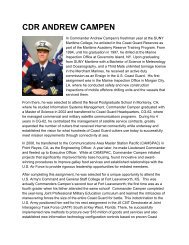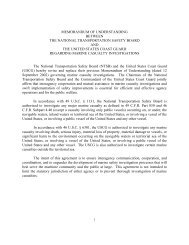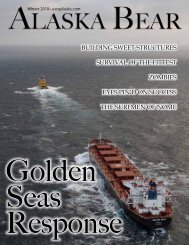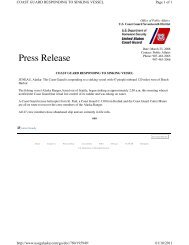marine board report - Off Soundings
marine board report - Off Soundings
marine board report - Off Soundings
Create successful ePaper yourself
Turn your PDF publications into a flip-book with our unique Google optimized e-Paper software.
The vessel was equipped with an ACR Electronics, Inc., 406 MHz EPIRB, serial number –<br />
0735/1999 and model number RLB-32. The expiration date of the EPIRB battery was<br />
November 2005. The EPIRB was properly registered with NOAA with the current data on file.<br />
Most of the safety equipment a<strong>board</strong> the ARCTIC ROSE functioned properly. The EPIRB<br />
deployed and emitted a signal, which was received by the orbiting satellite. The signal was then<br />
forwarded to the land station and sent via phone line to the Command Center in Juneau, Alaska<br />
alerting the watchstanders. The vessel’s inflatable liferaft did deploy and was found in an<br />
upright condition (although it was empty). The vessel’s two ring buoys were never located.<br />
Captain Rundall’s body was located within the debris field in a properly donned immersion suit.<br />
The immersion suit was full of water. The immersion suits were stowed in a wooden box at the<br />
port side of the pilothouse level on the weather deck (see Figure 6). Seven empty immersion<br />
suits were recovered by the vessels on scene, all of which were found out of their storage bags.<br />
6. TRAWLING AND PROCESSING OPERATIONS<br />
The ARCTIC ROSE was a stern trawler targeting the non-limited entry permit bottom fisheries<br />
(e.g., Pacific Cod, Rex Sole, Flathead Sole, Yellowfin Sole, and other bottom dwellers). The<br />
crew would deploy the trawl net to the ocean floor dragging the bottom for several hours at a<br />
time. When the operator felt the drag increase or reached the time limit for fishing, the net was<br />
retrieved. The cables were retrieved and spooled on winches located aft of the pilothouse on the<br />
weather deck. The net was hauled a<strong>board</strong> the vessel through the stern ramp and spooled on the<br />
net reel mounted within the “A” frame gantry. The cod end was hauled up the stern ramp and<br />
pulled into the dump box arrangement. The cod end was manipulated through the use of gilson<br />
winches and placed within the dump box. When the cod end was in place, the deckhands would<br />
attach a gilson line to the aft door of the dump box, lift the door into place and latch it shut. The<br />
cod end would be unzipped to empty the catch into the dump box. The hydraulically operated<br />
sliding chute on the aft bulkhead of the processing space could then be opened and the fish<br />
manually pushed into the live bin within the processing space where the catch was sorted by<br />
species. The by-catch (undesirable species) were placed on a conveyor belt and discarded<br />
through an over<strong>board</strong> chute on the star<strong>board</strong> side of the processing space. A separate conveyor<br />
belt carried the target species to the deheading machine. Once deheaded, the fish moved via<br />
conveyor belt to the cleaning area where they were cleaned of all viscera and blood. The head<br />
and guts were discarded through an over<strong>board</strong> chute on the port side. Cleaned fish were sorted,<br />
placed onto trays, and inserted into one of the three plate freezers. After three to four hours in a<br />
freezer, the frozen fish were put into paper bags referred to as fiber. The bags of fish were<br />
marked and dropped into the cargo hold via the manhole access in the deck hatch to be stacked.<br />
7. THE CASUALTY<br />
a. Departure from Dutch Harbor. The vessel topped off fuel on March 22, taking on 10,580<br />
gals of fuel and an unknown quantity of water from <strong>Off</strong>shore Industry Systems. On March<br />
28, 2001 the ARCTIC ROSE departed Captains Bay, Unalaska, Alaska with a fifteen man<br />
crew. Prior to calling on the port of St. Paul, the crew made several trawls in the Bering Sea<br />
in an area known as the Slime Banks that produced a small amount of yellow fin sole.<br />
15












